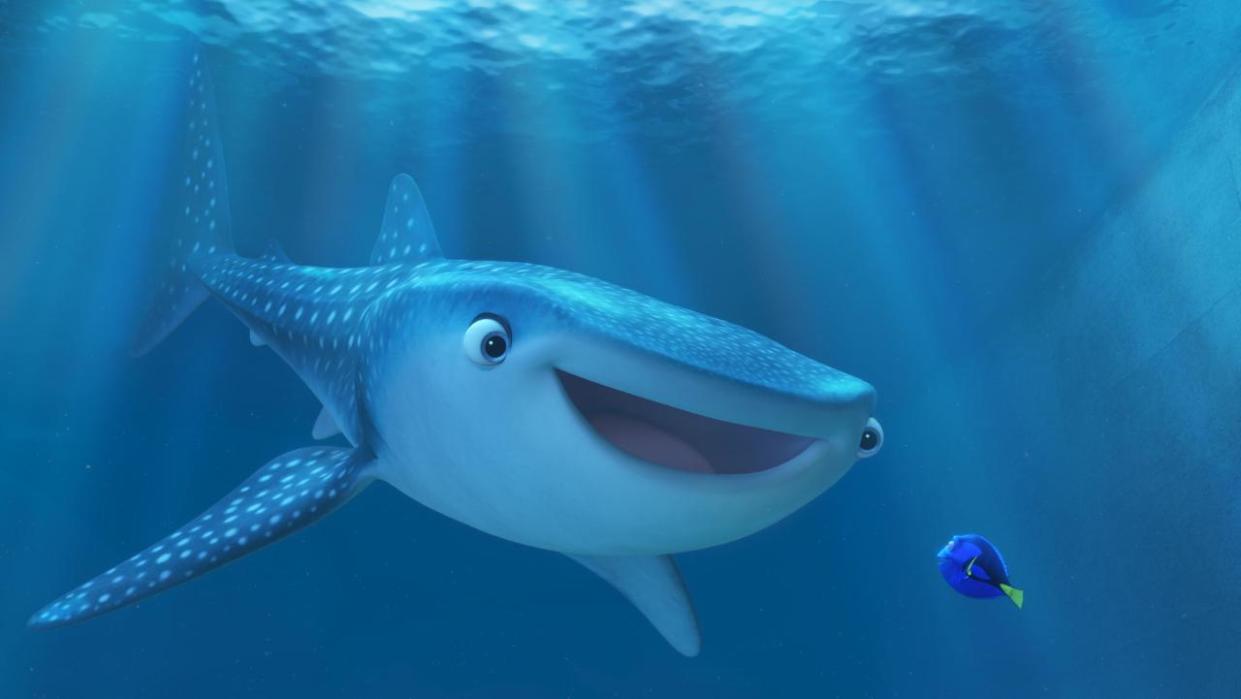How the Female Sidekicks in 'Finding Dory' Break New Ground

Destiny and Dory in ‘Finding Dory’ (Pixar/Disney via AP)
How is Dory different from other Disney movie heroines? Well, for one thing, she’s a fish. But there’s another, more subtle difference between the forgetful blue tang and her animated predecessors: Dory has female friends. It may seem trivial, but Finding Dory is a welcome break from the Disney tradition of surrounding its leading ladies with exclusively male sidekicks.
Related: Finding Tons of Easter Eggs in ‘Finding Dory’ (Spoilers!)
When Dory first appeared in 2003’s Finding Nemo, she was a comic foil for Marlin (Albert Brooks), the worrywart clownfish who sets off to find his lost son Nemo. Besides Marlin and Nemo, the film’s standout characters included sea turtles Crush and Squirt, shark Bruce, pelican Nigel, and stingray schoolteacher Mr. Ray — all male characters. In scenes where Nemo shared a fish tank with other kidnapped ocean fish, male fish outnumbered the female fish two to one. For most of the film, Dory had to just keep swimming through a man’s world.
Finding Dory is different. As the memory-impaired fish seeks out her long-lost parents, she encounters an old friend, a whale shark named Destiny (Kaitlin Olson). She also gets a helping hand from a loon named Becky, and converses in an early scene with a sympathetic female fish (Kate McKinnon) and her husband (Bill Hader). Dory’s mother (Diane Keaton) appears in flashbacks, playing a role equal to or greater than that of her father (Eugene Levy). Granted, Finding Dory’s sidekick ratio still skews male, with prominent appearances by grizzled octopus Hank (Ed O’Neill), beluga whale Bailey (Ty Burrell), a pair of comic sea lions (Idris Elba and Dominic West), and the original father-and-son stars of Finding Nemo. Still, the fact that there are so many female voices marks a small, but significant step forward.
Related: Red Carpet Flashback! ‘Finding Nemo’ Premiere in 2003
For contrast, think about the female characters in almost any previous Disney or Disney/Pixar animated film. Jessie from Toy Story? Surrounded by male toys. Ariel from The Little Mermaid? Surrounded by male fish. Belle, Pocahontas, Mulan, Alice, Snow White, Lilo, Alice, Anna and Elsa — all supported by casts of animals, fantasy creatures, and humans where men outnumber women by a significant margin. Funny female sidekicks occasionally found their way into these pictures (Mrs. Potts in Beauty and the Beast, the somewhat gender-ambiguous ape Terk in Tarzan), but to locate more than one or two in a single film, you have to go all the way back to Sleeping Beauty and its trio of fairies — or zoom forward to Pixar’s groundbreaking Inside Out with its personified emotions. (For by-the-numbers evidence of how most of the dialogue in Disney movies is voiced by men, check out this massive Polygraph study.)
Related: 'Moana’ Teaser: A Brief History of Disney Omitting Princesses From Princess Movie Trailers
This isn’t exclusively a problem with Disney movies: By and large, movies have many more male than female characters. (There’s even a term for the common pattern of all-male casts with a single woman: the Smurfette Principle.) But Disney movies do a good job at highlighting how ludicrous this convention is. Why doesn’t Pocahontas know some female woodland creatures? Why is Jasmine apparently the only non-male person (or animal or carpet) in Agrabah? How come everything from mice (Cinderella) to monsters (Monsters Inc., Monsters University) to household furnishings (Beauty and the Beast) to vehicles (Cars, Cars 2) is assumed to be male unless it’s pink or wearing a skirt?
For years, Disney Animation has been playing up its male sidekicks to make sure that its films aren’t perceived strictly as “girl” movies. (More on that here.) But when half the movie-going audience is female, why should the worlds onscreen be almost exclusively male? Girls shouldn’t grow up perceiving men as the norm and women as the exception in their entertainment. Dory nudges the male/female ratio closer to 50/50, and Disney should just keep swimming in that direction.
Watch the ‘Dory’ cast answer “what would Dory do?”

